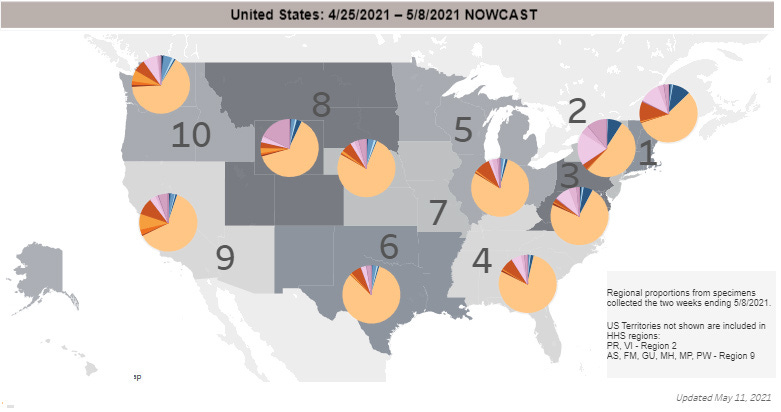Percent of Cases by Strain Grouped in 2-Week Blocks
Multiple variants of the virus that causes COVID-19 are circulating globally and within the United States.
To date, five variants have been classified as a variant of concern (VOC). Nowcast estimates of SARS-CoV-2 cases caused by these VOCs for the two weeks ending May 8 are summarized here.
Nationally, B.1.1.7 proportions are predicted to increase to 72.4%;
P.1 proportions are predicted to increase to 6.2%;
B.1.427/B.1.429 proportions are predicted to decrease; and
B.1.351 proportions are predicted to decrease
Variant Name: B.1.1.7
This variant is estimated to have first emerged in the UK during September 2020. Since December 20, 2020, several countries have reported cases of the B.1.1.7 lineage, including the United States.
This variant spreads faster and more easily.
Early reports found no evidence to suggest that the variant has any impact on the severity of disease or vaccine efficacy, but scientists in the UK where it first appeared now question that and found evidence it may be increasing the risk of death.
Variant Name: B.1.351
This variant was first identified in South Africa, in samples from October 2020. This variant has since been found in many other countries including the United States.
B.1.351 also appeared in Zambia in late December 2020, at which time it appeared to be the dominant strain.
B.1.351 variant does not appear to cause more deadly or severe illness.
Some evidence shows the current vaccines might be less effective against it but that’s not certain. Even if they are less effective, it’s unlikely the virus would totally outmaneuver the vaccines. Vaccines should offer at least partial protection.
Variant Name: P.1
The P.1 variant is a branch of the B.1.1.28 variant family that was first found in Japan in four travelers from Brazil.
P.1 appears to spread more easily and may differ enough that the vaccines or natural infection might not protect against it as well.
Cause for concern: The P.1 variant was identified in 42% of cases in a big outbreak from Dec 2020. This was the same location that had a massive outbreak in Oct 2020 where an estimated 75% of people had been infected.
Surging again in Dec 2020 may mean the natural immunity people got from their Oct 2020 infection doesn’t protect against P.1. We can’t say for sure yet.
This variant was identified in the United States at the end of January 2021.
Nowcast estimates predict that B.1.1.7 proportions will increase to more than 60% in HHS regions 3 – 10.
B.1.351 is predicted to increase in regions 3 and 10;
P.1 is predicted to increase in all regions except 7 and 8;
B.1.427/429 will be highest in regions 9 and 10.
B.1.617.2, a new variant of interest, is predicted to increase in regions 2, and 7 – 9.






